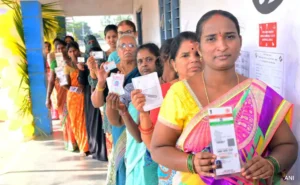As per the Election Commission’s announcement, the General elections in Haryana will be held in a single phase on May 25 while the counting will be done on collectively across the Nation on June 4, 2024.
In wake of this, the ruling Bhartiya Janta Party (BJP), Congress, Jannayak Janta Party (JJP), and the Indian National Lok Dal (INLD) are sweating profusely to emerge victorious on maximum Lok Sabha segments. Political analysts opine that since the Lok Sabha polls’ results are most likely to have far-reaching implications on assembly polls due in October, so by winning a maximum parliamentary seat, all political factions are making efforts to gain political mileage from the same. Since Haryana is a small state politically with10 Lok Sabha seats, but adjoining to the National capital Delhi and having other aspects simultaneously, it carries political significance. It is evident from the prevailing scenario that the Congress and the the BJP are eyeball to eyeball over a battle of dominance as well as supremacy in the polls and keeping in view the view of possible far-reaching implications of the Lok Sabha polls, the BJP and Congress along with JJP and INLD are having high hopes from polls’ result.
As part of the calculative strategy, BJP had come up with a major reshuffle in the government before the assembly elections in Gujarat in December 2022, the results of which were in line with the expectations for the party in the elections. In September 2021, just before the December 2022 Gujarat Assembly elections, the PM Narendra Modi-Amit Shah duo made a major change in Gujarat and replaced the CM there. Apart from this, the party had also changed the CM in Uttarakhand, the result of which was that the party was successful in forming the government here. The then Chief Minister of Gujarat, Vijay Rupani had resigned from the post without citing any reason. On the lines of Gujrat and Uttarakhand, the BJP has replaced the CM Manohar Lal with Nayab Saini I’m Haryana.
Political experts believe that by changing the CM before the elections, BJP has not only tried to eliminate the anti-incumbency factor of the party’s ten-year rule, but also has given this message to the cadre and the general public by including other new faces. Through the replacement of Manohar Lal from the Punjabi Community with Nayab Saini who hails from the OBC category, the saffron BJP has tried to establish that the aim of the party is all around the development of everyone as well as give equal opportunity to all ..
BJP was succeeded in forming the government with full majority by winning 47 seats in the 2014 assembly elections, but contrary to expectations, the party suffered a setback as the number was reduced to just 40 seats in the 2019 assembly elections. In view of this, the party had to resort the crutches of the Jananayak Janta Party (JJP), an entrant in the state politics then which entered the electoral battle successfully by winning 10 assembly seats as well as leaving its mark in state politics. Keeping in view its weakened performance in the assembly polls, the BJP is on toes to get an absolute majority at any cost while on the other hand, Congress, which has been in exile power in Haryana for the last decade, is also making every possible effort to come to power, but the split among the senior leaders of the party is emerging as a big problem for the party. Congress veterans Bhupendra Singh Hooda and SRK faction leaders including Kumari Selja, Randeep Surjewala, and Kiran Chaudhary are also well aware that if the performance in the Lok Sabha elections remains contrary to expectations then assembly polls result may result in a nightmare for the party in the state.
Amid this and in continuation to aforesaid, it is pertinent to mention that after the removal of Manohar Lal from the post of CM, a major reshuffle was also witnessed in the state cabinet with an to kill two birds with one stone. Earlier, among the five ministers who were sworn in on March 12, are MLA Kanwar Pal from Jagadhri in Yamunanagar, Moolchand Sharma, MLA from Ballabhgarh in Faridabad, MLA from Loharu in Mahendragarh Jai Prakash Dalal, MLA from Bawal in Rewari Banwari Lal and independent MLA from Raniya in Sirsa Ranjit Singh Chautala (recently joined BJP) were included. Further, in the cabinet expansion, Seema Trikha, MLA from Badkhal, Faridabad, was given a berth appointing her Education Minister. Apart from these, MLA from Ambala City Asim Goyal, MLA from Nangal Chaudhary area of Mahendragarh Abhay Singh Yadav, MLA from Panipat Rural Mahipal Dhanda, MLA from Thanesar in Kurukshetra Subhash Sudha, MLA from Bawani Kheda in Bhiwani Bishamber Singh Valmiki and MLA from Sohna in Gurugram and Sanjay Singh were also sworn in as ministers. There are eight new faces out of a total of 14 people including the CM, which is more than 50 percent change in the cabinet. In this, caste equations were also kept in mind for electoral gains in Lok Sabha and Assembly elections as induction of ministers hailing from different communities was ensured.














